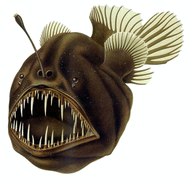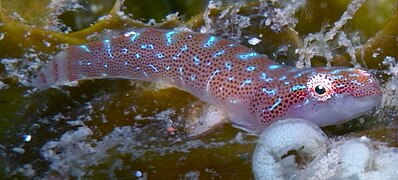Fish/ja: Difference between revisions
Created page with "<gallery mode=packed widths=150 heights=180> File:Matsya painting.jpg|化身としてのヴィシュヌ(マツヤ)、インド File:Bartolomeo Passerotti - The Fishmonger's Shop - WGA17072.jpg|『魚屋』、バルトロメオ・パッセロッティ、1580年代 File:Goldfish Matisse.jpg|『金魚』 アンリ・マティス、1912年 </gallery>" Tags: Mobile edit Mobile web edit |
|||
| (4 intermediate revisions by the same user not shown) | |||
| Line 357: | Line 357: | ||
歴史を通じて、人間は[[fish as food/ja|魚を食料資源]]として[[dietary protein/ja|食事のタンパク質]]源に利用してきた。過去から現在に至るまで、人間の消費のために漁獲される魚の大部分は野生魚を捕獲することによって得られてきた。しかし、紀元前3500年頃の古代中国で始まった養殖漁業は、多くの国々でますます重要になっている。世界全体で、およそ6分の1のタンパク質が魚によって供給されていると推定されている。したがって[[:en:Fishing|漁業]]は世界的に大規模な事業であり、数百万人に収入をもたらしている。[[:en:Environmental Defense Fund|環境防衛基金]]は、現代世界の汚染状況を考慮して安全に食べられる魚と持続可能な方法で得られる魚についてのガイドを提供している。2020年の時点で、6500万トン以上の海水魚と1000万トンの淡水魚が漁獲され、一方で主に淡水魚を中心とした約5000万トンの魚が養殖された。2020年に漁獲された海水魚種のうち、[[anchoveta/ja|アンチョベータ]]は490万トン、[[Alaska pollock/ja|アラスカスケトウダラ]]は350万トン、[[skipjack tuna/ja|カツオ]]は280万トン、[[Atlantic herring/ja|大西洋ニシン]]および[[yellowfin tuna/ja|キハダマグロ]]はそれぞれ160万トンであり、さらに8種の魚が100万トン以上漁獲された。 | 歴史を通じて、人間は[[fish as food/ja|魚を食料資源]]として[[dietary protein/ja|食事のタンパク質]]源に利用してきた。過去から現在に至るまで、人間の消費のために漁獲される魚の大部分は野生魚を捕獲することによって得られてきた。しかし、紀元前3500年頃の古代中国で始まった養殖漁業は、多くの国々でますます重要になっている。世界全体で、およそ6分の1のタンパク質が魚によって供給されていると推定されている。したがって[[:en:Fishing|漁業]]は世界的に大規模な事業であり、数百万人に収入をもたらしている。[[:en:Environmental Defense Fund|環境防衛基金]]は、現代世界の汚染状況を考慮して安全に食べられる魚と持続可能な方法で得られる魚についてのガイドを提供している。2020年の時点で、6500万トン以上の海水魚と1000万トンの淡水魚が漁獲され、一方で主に淡水魚を中心とした約5000万トンの魚が養殖された。2020年に漁獲された海水魚種のうち、[[anchoveta/ja|アンチョベータ]]は490万トン、[[Alaska pollock/ja|アラスカスケトウダラ]]は350万トン、[[skipjack tuna/ja|カツオ]]は280万トン、[[Atlantic herring/ja|大西洋ニシン]]および[[yellowfin tuna/ja|キハダマグロ]]はそれぞれ160万トンであり、さらに8種の魚が100万トン以上漁獲された。 | ||
=== レクリエーション === | |||
=== | {{further/ja|:en:Fishkeeping|:en:Recreational fishing}} | ||
{{further|Fishkeeping|Recreational fishing}} | |||
魚は食料として利用されてきたのとほぼ同じくらい長い間、美的な対象として認識されてきた。魚は[[:en:cave art|洞窟壁画]]に描かれ、池で[[:en:ornamental fish|観賞魚]]として飼育され、家庭や職場、公共の場の[[:en:aquarium|水族館]]で展示されてきた。レクリエーションとしての釣りは、主に娯楽や競技を目的とした釣りであり、利益を目的とした商業漁業や、主に食料を目的とした[[:en:artisanal fishing|沿岸小規模漁業]]とは対照的である。レクリエーション釣りの最も一般的な形態は、[[:en:fishing rod|釣り竿]]、[[:en:fishing reel|リール]]、[[:en:fishing line|釣り糸]]、[[:en:fish hook|釣り針]]、および幅広い[[:en:bait (luring substance)|餌]]を用いるものである。レクリエーション釣りは特に北米やヨーロッパで人気があり、政府機関が対象魚種を積極的に管理することが多い。 | |||
< | <span id="Culture"></span> | ||
=== | === 文化 === | ||
{{main/ja|:en:Fish in culture}} | |||
{{main|Fish in culture}} | |||
魚を題材とするテーマは多くの宗教で象徴的な意味を持つ。古代[[:en:Mesopotamia|メソポタミア]]では、最も初期から神々への供物として魚が捧げられていた。魚はまた、水の神である[[:en:Enki|エンキ]]の主要な象徴でもあった。魚は[[:en:First Babylonian dynasty|古バビロニア王朝]](紀元前1830年頃–紀元前1531年頃)や[[:en:Neo-Assyrian Empire|新アッシリア帝国]](紀元前911年–紀元前609年)の[[:en:cylinder seal|円筒印章]]に充填模様として頻繁に登場する。[[:en:Kassites|カッシート時代]](紀元前1600年頃–紀元前1155年頃)から[[:en:Achaemenid Empire|アケメネス朝ペルシア時代]]初期(紀元前550年–紀元前30年頃)にかけて、治療師や祓魔師は魚の体を模した祭礼衣装を身につけた。[[:en:Seleucid Empire|セレウコス朝]]時代(紀元前312年–紀元前63年)、伝説的なバビロニアの[[:en:culture hero|文化英雄]]である[[:en:Oannes (mythology)|オアンネス]]は魚の皮をまとっていたと言われている。魚はシリアの女神[[:en:Atargatis|アタルガティス]]にとって神聖なものであり、彼女の祭りの間、魚を食べることが許されたのは彼女の神官だけであった。[[:en:Book of Jonah|『ヨナ書』]]では、主人公である[[:en:prophet|預言者]][[:en:Jonah|ヨナ]]が乗船していた船から投げ出された後、大魚に呑み込まれる。[[:en:Early Christianity|初期キリスト教徒]]は、イエスを象徴するために魚のシンボルである''[[:en:ichthys|イクトゥス]]''を用いた。魚の姿をとるとされる[[:en:deity|神々]]には、[[:en:Polynesians|ポリネシア人]]の[[:en:Ikatere|イカテレ]]、[[:en:Hawaii|ハワイ]]のサメの神[[:en:Kāmohoaliʻi|カーモホアリイ]]、ヒンドゥー教の[[:en:Matsya|マツヤ]]がいる。[[:en:Pisces (constellation)|うお座]](「魚たち」)は、古代ローマの伝説において[[:en:Venus (mythology)|ヴィーナス]]とその息子[[:en:Cupid|クピードー]]が二匹の魚に救われたことと結び付けられている。 | |||
魚は芸術において顕著に描かれ、映画『''[[:en:Finding Nemo|ファインディング・ニモ]]''』や書籍『''[[:en:The Old Man and the Sea|老人と海]]''』などに登場する。特にサメのような大型魚はしばしば[[:en:Horror film|ホラー映画]]や[[:en:Thriller (genre)|スリラー]]の題材となってきた。とりわけ小説『''[[:en:Jaws (novel)|ジョーズ]]''』は映画化され、その後何度もパロディや模倣が作られた。ピラニアもまた、『''[[:en:Piranha (1978 film)|ピラニア]]''』などの映画でサメと同様に描かれている。 | |||
<gallery mode=packed widths=150 heights=180> | <gallery mode=packed widths=150 heights=180> | ||
File:Matsya painting.jpg|[[Avatar]] | File:Matsya painting.jpg|[[:en:Avatar|化身]]としての[[:en:Vishnu|ヴィシュヌ]]([[:en:Matsya|マツヤ]])、インド | ||
File:Bartolomeo Passerotti - The Fishmonger's Shop - WGA17072.jpg| | File:Bartolomeo Passerotti - The Fishmonger's Shop - WGA17072.jpg|『魚屋』、[[:en:Bartolomeo Passerotti|バルトロメオ・パッセロッティ]]、1580年代 | ||
File:Goldfish Matisse.jpg| | File:Goldfish Matisse.jpg|『[[:en:Goldfish (Matisse)|金魚]]』 [[:en:Henri Matisse|アンリ・マティス]]、1912年 | ||
</gallery> | </gallery> | ||
== 関連項目 == | == 関連項目 == | ||
Latest revision as of 20:35, 1 September 2025
| 魚類 | |
|---|---|

| |
| バラ・シャーク、硬骨魚類 | |
| Scientific classification | |
| Domain: | Eukaryota |
| Kingdom: | Animalia |
| Phylum: | Chordata |
| Clade: | Olfactores |
| Subphylum: | Vertebrata |
| Groups included | |
| Cladistically included but traditionally excluded taxa | |
魚類とは、水生で、無羊膜類であり、鰓を持つ脊椎動物であって、遊泳のための鰭と頭蓋骨を有するが、四肢および指を欠くものである。魚類は、より基盤的な無顎魚類と、より一般的な顎口魚類に大別され、後者には現生の軟骨魚類と硬骨魚類、さらに絶滅した板皮類と棘魚類が含まれる。長く続いた全ての魚類を一つの綱(''Pisces'')にまとめる伝統から離れ、現代の系統学は魚類を側系統群と見なしている。
大部分の魚類は変温動物であり、体温は周囲の水温に応じて変化するが、ホオジロザメやマグロのような大型の活発な遊泳者はより高い体幹温度を維持することができる。多くの魚は音響による通信を行い、例えば求愛行動の際などに利用される。魚類の研究は魚類学と呼ばれる。
現生の魚類は3万3,000種以上が知られており、これは両生類、爬虫類、鳥類、哺乳類の全種を合わせた数よりも多い。魚類の大部分は条鰭類に属し、これは現存する脊椎動物のおよそ半分を占める。このため魚類は種数において最大の脊椎動物群である。
最初期の魚類はカンブリア紀に出現し、小型の濾過摂食者であった。彼らは古生代を通じて進化を続け、多様な形態に分化した。専用の呼吸用鰓と対鰭をもつ最初の魚類である甲皮類は、重厚な骨質の装甲板をもち、無脊椎捕食者に対する防御的な外骨格として機能した。顎をもつ最初の魚類である板皮類はシルル紀に出現し、デボン紀(「魚の時代」)に大きく多様化した。
浮き袋と、後には骨化した内骨格をもつことによって区別される硬骨魚類は、デボン紀末の大量絶滅で板皮類という頂点捕食者が消滅した後、優勢な魚類群となった。硬骨魚類はさらに肉鰭類と条鰭類に分けられる。現生魚類の約96%は真骨類であり、これは冠群に属する条鰭類で、顎を前方に突き出すことができる。四肢動物は、主として陸生のクレードであり、後期古生代以降、水界および陸界双方の食物連鎖上位を支配してきたが、これらは石炭紀に肉鰭類から進化し、肺を獲得した。肺は浮き袋と相同である。系統分類学的には四肢動物は魚類に含まれるが、通常は魚類とは見なされない。
魚類は先史時代以来、特に食料として人類にとって重要な天然資源であった。商業漁業や自給漁業において、魚類は天然漁場で捕獲されるか、または養魚池や海上の養殖かごで養殖される。魚類は娯楽目的の釣りで捕獲されたり、観賞魚飼育者によって観賞魚として飼育され、水族館や庭園の池に展示される。魚類は古来より人間文化において、神格や宗教的象徴、美術・文学・映画の題材として役割を果たしてきた。
語源
fishという語はプロト・ゲルマン語に由来し、ドイツ語 Fisch、ラテン語 piscis、古アイルランド語 īascと関連しているが、正確な語根は不明である。一部の学者は、プロト・インド・ヨーロッパ語の語根 *peysk- を再構築しており、これはイタリック語派、ケルト語派、ゲルマン語派にのみ証拠がある。
しばしば同義に用いられるが、生物学において fish と fishes は異なる意味を持つ。fish は単数名詞として、または単一種に属する複数個体を指す複数形として用いられる。fishes は異なる種や種群を表すのに用いられる。
進化
化石の歴史

約5億3000万年前のカンブリア爆発の時期、Haikouichthys のように脊索と体の前方に目を持つ魚に似た動物が化石記録に現れる。後期カンブリア紀には、コノドントなどの他の無顎類が現れる。
顎口類はシルル紀に出現し、Dunkleosteus のような巨大な装甲板皮類がいた。顎を持つ魚類もまたシルル紀に出現し、軟骨魚類と硬骨魚類が含まれる。
デボン紀には魚類の多様性が大きく増加し、板皮類、肉鰭類、初期のサメ類を含み、デボン紀は「魚の時代」と呼ばれることになった。
系統発生
魚類は側系統群である。なぜなら、全ての魚類を含むクレード、例えば顎口類や(硬骨魚類の場合は)硬骨魚類は、通常は魚類とは見なされない四肢動物(主に陸上に生息する脊椎動物)のクレードも含むからである。クジラ類や魚竜のような一部の四肢動物は、収斂進化によって二次的に魚に似た体形を獲得している。一方で、Fishes of the World では「四肢動物を含む我々自身は単に修飾された硬骨魚類にすぎないという考えが広く受け入れられつつあり、したがって四肢動物を含む分類群として硬骨魚類を用いることに違和感はない」と述べている。
現生魚類の生物多様性は群ごとに不均一に分布しており、顎を突き出すことができる硬骨魚類である条鰭亜綱が魚種の96%を占める。クラドグラムは、現存する全ての魚類群(それぞれの多様性を含む)と四肢動物の進化的関係を示している。絶滅した群は短剣符号 (†) で示され、位置が不確かな群は疑問符 (?) と破線 (- - - - -) で示される。2万5000種以上を含む群は太字で示される。
| 脊椎動物 |
| ||||||||||||||||||||||||||||||||||||||||||||||||||||||||||||||||||||||||||||||||||||||||||
分類
魚類(四肢動物を除く)は側系統群であり、このため古い参考文献に見られる Pisces という綱は正式な分類ではもはや使用されていない。伝統的な分類では、魚類は3つの現生綱(「無顎類」、軟骨魚類、および「硬骨魚類」)に分けられ、絶滅した形態は時にそれらの群に含められ、時に独自の綱として分類される。
魚類は脊椎動物種の半数以上を占める。2016年時点で、硬骨魚類は3万2000種以上、軟骨魚類は1100種以上、ヌタウナギとヤツメウナギは100種以上が記載されている。これらのうち3分の1は9つの最大の科に属しており、大きい順にコイ科、ハゼ科、シクリッド科、カラシン科、プレコ科、ドジョウ科、ハタ科、ベラ科、カサゴ科である。約64科は単型で、1種しか含まない。
<
多様性
魚類の大きさは巨大な16-metre (52 ft)のジンベエザメから、全長わずか8-millimetre (0.3 in)の極小の条鰭類まで幅があり、後者にはコイ科の パエドキプリス・プロゲネティカ やインファントフィッシュが含まれる。
-
最大: ジンベエザメ
-
最小: 例 パエドキプリス・プロゲネティカ
遊泳能力は種によって異なり、マグロ、サケ、アジ科のように1秒間に体長の10–20倍を泳ぐものもあれば、ウナギやエイのように1秒間に体長の0.5倍を超えないものもいる。
典型的な魚類は変温動物であり、速く泳ぐための流線形の体を持ち、鰓で水から酸素を取り込み、2対の対鰭、1つまたは2つの背鰭、臀鰭と尾鰭、顎、鱗に覆われた皮膚を持ち、卵を産む。これらの基準にはそれぞれ例外があり、体形や生活様式に大きな多様性を生み出している。例えば、速く泳ぐ魚の中には恒温性を示すものがあり、遅く泳ぐ魚の中には流線形を捨てて別の体形を持つものもいる。
生態
生息環境

魚類はほぼ半数が淡水生態系、残り半数が海洋生態系に分布する。淡水魚は約1万5200種、海水魚は約1万4800種が知られている。インド太平洋のサンゴ礁は海洋魚類の多様性の中心であり、大陸の淡水魚はアマゾン、コンゴ、メコンなどの熱帯雨林の大河川流域で最も多様である。ネオトロピカルの淡水域だけで5600種以上が生息し、ネオトロピカル魚類は地球上の全脊椎動物種の約10%を占める。
魚類はほとんどの水域に豊富に存在する。高地の山岳渓流(例:イワナ、カマツカ)から、最深部の深海底域や超深海帯(例:アシロ目、ダンゴウオ科)に至るまでほぼすべての水環境に分布している。ただし海洋の最深部の25%では発見されていない。これまでに知られている最も深い海に生息する魚はアシロ目の ヨミノアシロ で、プエルトリコ海溝の水深8,370 m (27,460 ft)で記録されている。
温度に関しては、ヨナアイスフィッシュは南極海の冷水域、例えばフィルヒナー=ロンネ棚氷の南緯79度で生息する。一方、デザートパプフィッシュは砂漠の泉や流れ、湿地に生息し、ときに高度に塩分を含む水温36℃にも達する環境に適応している。少数の魚類は陸上で生活したり、水辺の陸上に産卵したりする。ムツゴロウは干潟で採餌や社会的相互作用を行い、巣穴に潜って水中に隠れる。Phreatobius 属の未記載種の1種は真の「陸生魚」と呼ばれ、このミミズ状のナマズは湿った落葉の間で生活する。さらに複数の科に属する洞窟魚は地下湖、地下河川、帯水層に生息する。
寄生者と捕食者
他の動物と同様、魚類も寄生に苦しむ。ある種は外部寄生虫を取り除くためにクリーナーフィッシュを利用する。最もよく知られているのはインド洋や太平洋のサンゴ礁に生息するホンソメワケベラである。これらの小型魚は「クリーニングステーション」を維持し、他の魚が集まり、特定の動作を行ってクリーナーの注意を引く。クリーニング行動は多くの魚類群で観察されており、興味深い例として、同じ属に属する2種のシクリッド、クリーナー役の Etroplus maculatus と、より大型の E. suratensis との間で見られる。
魚類は淡水および海洋の食物網において多くの栄養段階を占める。高次の魚類は捕食者であり、その餌のかなりの部分は他の魚類である。加えて、イルカやアシカ・アザラシなどの哺乳類、カツオドリやウミウなどの鳥類も魚類を捕食する。
解剖学と生理学
運動
典型的な魚の体は、背骨の両側にある対になった筋肉を交互に収縮させることで効率的に泳ぐように適応している。この収縮は体を伝わるS字型の曲線を形成する。各曲線が尾びれに達すると、水に力が加わり、魚は前方に進む。他のひれは、航空機のフラップのような操縦面として作用し、魚が任意の方向に操縦することを可能にする。
体組織は水よりも密度が高いため、魚はその差を補わなければ沈んでしまう。多くの硬骨魚は、内部器官である浮き袋をもち、その中のガスの量を増減させることで浮力を調節できる。
鱗は捕食者からの保護を提供するが、その代償として剛性と重量を増す。魚の鱗はしばしば高度に反射的であり、この銀化は迷彩効果を提供する。周囲の水がすべて同じ色であるため、水の像を反射することによってほぼ透明となる。
循環

魚は閉鎖循環系をもつ。心臓は血液を単一のループで全身に送り出す。比較すると、哺乳類の心臓は二つのループをもち、一つは肺で酸素を取り込むため、もう一つは体に酸素を届けるためである。魚では心臓が血液をえらに送る。酸素に富んだ血液は哺乳類とは異なり、追加の拍動なしで体組織に流れる。最終的に酸素が減少した血液は心臓に戻る。
呼吸
えら
魚は咽頭の両側にあるえらを使ってガス交換を行う。えらはフィラメントと呼ばれる櫛状の構造から成り立っている。各フィラメントには毛細血管網が含まれており、酸素と二酸化炭素を交換するための広い表面積を提供する。魚は酸素に富む水を口から取り込み、それをえらに送り出すことでガス交換を行う。えら内の毛細血管の血液は水とは逆方向に流れ、効率的な対向流交換をもたらす。えらは酸素の乏しい水を咽頭の側面にある開口部から押し出す。軟骨魚は複数のえらの開口部を持ち、サメは通常5対、時には6対または7対をもつことがあり、彼らはしばしばえらに酸素を供給するために泳がなければならない。硬骨魚は各側に1つのえらの開口部をもち、保護的な骨の覆い、すなわちえらぶたの下に隠されている。彼らは頭部の筋肉を使ってえらに酸素を供給することができる。
空気呼吸
約50科400種の魚は空気呼吸が可能であり、酸素の乏しい水中や陸上に出ることを可能にしている。魚がこれを行う能力は、単一循環系によって制限される可能性があり、空気呼吸器官からの酸素化された血液が、体の他の部分から心臓に戻る酸素の乏しい血液と混合することになる。肺魚、ポリプテルス、ロープフィッシュ、アミア、スネークフィッシュ、アフリカナイフフィッシュは、このような混合や酸素が乏しい水へのえらからの酸素損失を減らすように進化してきた。ポリプテルスと肺魚は四肢動物に似た対の肺をもち、空気を吸い込むために水面に浮上する必要があり、義務的な空気呼吸者である。他の多くの魚は、潮だまりや潮間帯に生息するものを含み、条件付き空気呼吸者であり、干潮時などに水外で空気を吸うことができ、水中ではえらを利用する。ロックスキッパーやムツゴロウのような沿岸の魚は、空気に一時的にさらされた生息地で餌を取るために水から出ることを選ぶ。ある種のナマズは消化管を通して空気を吸収する。
消化
消化器系は、口から肛門まで続く管、すなわち腸管から成る。多くの魚の口には、獲物を捕らえる、植物質を噛み取るまたは削り取る、あるいは食物を砕くための歯がある。食道は食物を胃へ運び、胃では食物が蓄えられ部分的に消化されることがある。括約筋である幽門が間隔をおいて食物を腸に放出する。多くの魚は幽門の周囲に幽門盲嚢と呼ばれる指状の嚢をもち、その機能は不明である。膵臓は消化酵素を腸に分泌し、食物を消化する。他の酵素は腸自体によって直接分泌される。肝臓は胆汁を生成し、脂肪を乳化して腸で吸収可能にする。
排泄
多くの魚は窒素性廃棄物をアンモニアとして排出する。これはえらを通じて排泄されるか、またはろ過されて腎臓によって排出される。塩は直腸腺によって排出される。海水魚は浸透によって水を失いやすく、腎臓は体に水を戻し、濃縮尿を生成する。逆に淡水魚では水を浸透で得やすく、希釈尿を生成する。ある魚は淡水と海水の両方で機能する腎臓をもつ。
脳

魚の脳は体の大きさに比べて他の脊椎動物よりも小さく、同程度の大きさの鳥や哺乳類の脳の質量の15分の1程度である。しかし、比較的大きな脳をもつ魚も存在し、とりわけモルミルス科やサメは、体重に対する脳の大きさが鳥や有袋類に匹敵する。脳の前方には嗅葉があり、これは一対の構造で、二つの嗅神経を通じて鼻孔からの信号を受け取り処理する。ヤツメウナギやサメのように主に嗅覚で狩りを行う魚は非常に大きな嗅葉をもつ。その後方には大脳があり、魚では主に嗅覚を処理する。これらの構造を合わせて前脳を形成する。前脳と中脳をつなぐのが間脳であり、ホルモンや恒常性に関与する。松果体は間脳のすぐ上にあり、光を感知し、概日リズムを維持し、体色変化を制御する。中脳には二つの視葉が含まれる。これらはニジマスやシクリッドのように視覚で狩りを行う種で非常に大きい。後脳は遊泳と平衡を制御する。単葉の小脳は脳の最大部分であり、ヤツメウナギやヌタウナギでは小さいが、モルミルス科では非常に大きく、彼らの電気感覚を処理する。脳幹すなわち延髄は一部の筋肉や体の器官を制御し、呼吸と浸透圧調節を統御する。
感覚系
側線系は皮膚にある感覚器のネットワークで、弱い水流や振動を検出し、捕食者であれ獲物であれ近くの魚の動きを感知する。これは触覚と聴覚の両方に相当すると考えられる。メクラウオは、ほぼ完全に側線系からの感覚によって遊泳する。ナマズやサメのような一部の魚は、ロレンチーニ器官と呼ばれる電気受容器をもち、ミリボルト程度の弱い電流を検出する。
視覚は魚において重要な感覚系である。魚の目は陸生の脊椎動物(鳥類や哺乳類)の目と似ているが、より球状の水晶体をもつ。彼らの網膜には一般に桿体と錐体があり(薄明視と明所視のため)、多くの種は色覚をもち、しばしば3種類の錐体を有する。硬骨魚類は偏光を見ることができ、コイ科のような一部は紫外線を検出する第4の錐体をもつ。無顎類の中では、ヤツメウナギはよく発達した目をもつが、ヌタウナギは原始的な眼点しかもたない。
聴覚もまた魚において重要な感覚系である。魚は側線と頭部内部の耳にある耳石を使って音を感知する。種によっては浮き袋を通して音を感知できるものもいる。
サケを含む一部の魚は磁気受容が可能であり、若魚を入れた円形の水槽の周囲で磁場の軸を変えると、魚はその磁場に沿って方向を変える。魚の磁気受容の仕組みは不明のままであるが、鳥類での実験は量子的なラジカル対機構を示唆している。
認知
魚の認知能力には自己認識が含まれ、これは鏡映試験で確認されている。オニイトマキエイやベラは鏡の前に置かれると、映像の行動が自分の体の動きを模倣しているかを繰り返し確認する。Choerodon 属のベラ、テッポウウオ、タイセイヨウタラは問題解決や道具の発明が可能である。一夫一婦制のシクリッドAmatitlania siquiaは、つがいと一緒にいられない時に悲観的な行動を示す。魚はランドマークを用いて位置を把握し、複数のランドマークに基づく心的地図を利用することもある。魚は迷路を通過することを学習でき、空間記憶や視覚的弁別能力を有していることを示す。行動研究は魚が感覚能力をもち、痛みを経験できることを示唆している。
発電

電気魚であるモルミルス科、アフリカナイフフィッシュ、デンキウナギなどは、筋肉の一部が電場を発生させるように適応している。彼らはその電場を用いて周囲の濁ったり暗い水中で獲物などの物体を探知・識別する。デンキウナギのような強電魚はさらに発電器官を用いて獲物を気絶させるほど強力な電撃を発生させることができる。
恒温性
ほとんどの魚は完全に変温動物すなわち外温性である。しかし、サバ亜目には恒温性(内温性)の魚が含まれ、カジキ類やマグロがそれにあたる。アカマンボウはマンボウ目の魚で、全身恒温性をもち、遊泳筋で熱を発生させて体を温め、対向流交換によって熱損失を最小化する。軟骨魚類の中では、ネズミザメ科(ホホジロザメなど)やオナガザメ科(オナガザメ)が恒温性を示す。恒温性の程度は、目と脳のみを温めるカジキ類から、環境水温より20℃以上高い体温を維持するクロマグロやネズミザメまで様々である。
繁殖と生活環

主要な生殖器官は対の精巣と卵巣である。卵は卵巣から輸卵管へ放出される。サケやキンギョを含む97%以上の魚は卵生であり、卵は母体外に放出され、水中で発生する。卵は通常、雌雄が配偶子を周囲の水中に放出することで体外受精される。エイ類のような一部の卵生魚では受精は体内で行われ、雄は交接器官を用いて精子を雌の生殖口に注入する。海産魚は多数の小卵を外洋に放出する。卵生魚のふ化直後の仔魚は仔魚プランクトンであり、大きな卵黄嚢をもち、稚魚や成魚とは似ていない。卵生魚の仔魚期は通常数週間にすぎず、急速に成長して形態変化し、稚魚となる。この移行期には、仔魚は卵黄嚢から動物プランクトン捕食への切り替えを行わなければならない。カワスズメ科、グーデア科、レモンザメのような一部の魚は胎生であり、母体が卵を保持し、胎盤に類似した構造を通じて母体の血流から胚を栄養する。
DNA修復
体外受精する魚類の胚は、その発生過程で汚染物質、紫外線、活性酸素種などDNAを損傷させる環境条件に直接さらされる。このようなDNA損傷に対処するため、魚の胚は発生中にさまざまなDNA修復経路を利用する。近年ではゼブラフィッシュが、遺伝毒性すなわちDNA損傷を引き起こす可能性のある環境汚染物質を評価するための有用なモデルとなっている。
疾病に対する防御
魚は非特異的防御と免疫防御の両方をもつ。非特異的防御には皮膚と鱗、そして表皮から分泌される粘液層があり、これが微生物の成長を捕捉し抑制する。病原体がこれらの防御を突破した場合、自然免疫系が炎症反応を起こし、感染部位への血流を増加させ、病原体を非特異的に破壊しようとする白血球を送り込む。特異的防御は特定の抗原に応答し、例えば病原菌表面のタンパク質を獲得免疫系が認識する。免疫系は新口動物において進化したことが系統樹に示されている。
| 新口動物 |
| ||||||||||||
| 自然免疫 |
免疫器官は魚の種類によって異なる。無顎類は前腎内にリンパ組織をもち、腸に顆粒球をもつ。彼らは独自の獲得免疫系をもち、可変リンパ球受容体(VLR)を利用して広範な抗原に対する免疫を生成する。その結果は有顎類魚類や四肢動物とよく似ているが、収斂進化により独自に進化した可能性がある。すべての有顎類魚類はB細胞とT細胞にそれぞれ免疫グロブリンとT細胞受容体を備えた獲得免疫系をもつ。これはV(D)J再構成を利用して広範な抗原に対する免疫を作り出す。このシステムは一度進化し、有顎脊椎動物のクレードの基盤となった。軟骨魚類は3つの特殊な免疫器官をもち、それぞれ生殖腺の周囲にあるエピゴナル器官、食道内のライディッヒ器官、腸内の螺旋弁であり、彼らの胸腺と脾臓は四肢動物の免疫系における同じ器官と類似の機能をもつ。硬骨魚類は胸腺にリンパ球をもち、脾臓や他の器官に他の免疫細胞をもつ。
行動
群泳と群れ泳ぎ

「shoal(群泳)」とは、各魚が独立して遊泳や採餌を行うが、群れの他の個体に引き寄せられ、遊泳速度などの行動を調整して群れの他の個体の近くにとどまる、ゆるやかに組織された集団である。「school(群れ泳ぎ)」はより厳密に組織された集団であり、全ての魚が同じ速度、同じ方向に移動するように遊泳を同期させる。群れ泳ぎはしばしば捕食者回避適応であり、捕食者に対する警戒を高める役割を持つ。群れで協力する方が採餌が効率的であることが多く、各魚は群れに加わるか離れるかを選択することで戦略を最適化する。捕食者を感知したとき、獲物となる魚は防御的に反応し、同期した動きのような集団行動が発現する。反応は単に隠れたり逃げたりすることに限らず、分散して再集合するなどの捕食者回避戦術も含まれる。魚はまた産卵のために群泳する。カペリンは、採餌場と産卵場の間を大規模な群れで毎年回遊する。
コミュニケーション
魚は音響信号(音)を互いに送ることでコミュニケーションを行う。これは主に採餌、攻撃、求愛の文脈で見られる。発せられる音は種や関与する刺激によって異なる。魚は骨格系の要素を動かして発声音を出すか、または浮き袋のような特殊な器官を操作して非発声音を生じさせることができる。

一部の魚は骨をこすり合わせることで音を出す。これらの音は発声音である。Haemulon flavolineatum(フレンチグラントフィッシュ)は、とりわけ苦痛時に歯をこすり合わせて低い唸り声のような音を出す。唸り声はおよそ700Hzの周波数で、約47ミリ秒続く。リーディタツノオトシゴは、神経頭蓋の溝部分に王冠骨をこすりつけることで、「クリック音」と「グロウル音」という二種類の音を発する。クリック音は求愛や採餌の際に発せられ、その周波数は50Hzから800Hzの範囲にある。産卵時、雌雄が15センチ未満まで接近した場合には周波数が範囲の高い方に集中する。グロウル音はH. reidiがストレス下にあるときに発せられる。このグロウル音は一連の音のパルスで構成され、体の振動と同時に放出される。
一部の魚種は、特殊な筋肉を収縮させて浮き袋を振動させることで音を生じる。カエルウオは、浮き袋の側面に沿って配置された発音筋を収縮させることで大きな唸り声を発する。雌雄のカエルウオは短時間の唸り声を発し、これはしばしば驚愕反応として現れる。加えて、雄のカエルウオは「ボートホイッスルコール」と呼ばれる音も発する。これはより長く、より低周波で、主に配偶者を引き寄せるために用いられる。これらの音の周波数範囲は140Hzから260Hzである。音の周波数は発音筋の収縮速度に依存する。
アカドラムは浮き袋を振動させることで太鼓のような音を発する。この振動は浮き袋の背側を取り囲む発音筋の急速な収縮によって引き起こされる。この振動により100Hzから200Hz以上の周波数を持つ繰り返し音が生成される。S. ocellatusは、求愛や捕食者の攻撃など、関与する刺激によって異なる発声を行う。雌は音を発さず、音を発する発音筋を欠いている。
保全
2024年のIUCN レッドリストでは、絶滅危惧または深刻な絶滅危惧に分類される魚種は2,168種とされている。そこには大西洋タラ、シーラカンス、ホホジロザメなどが含まれる。魚は水中に生息するため、陸上の動植物よりも研究が難しく、魚の個体群に関する情報が不足していることが多い。しかし淡水魚は特に脅威にさらされているように見える。これは淡水魚が比較的小さな水域に生息することが多いためである。例えば、デビルズホール・ププフィッシュは、3 by 6 metres (10 by 20 ft)の単一の水たまりにしか生息していない。
過剰漁獲

国際連合食糧農業機関は「2017年には、世界の海洋漁業の魚資源の34%が過剰漁獲と分類された」と報告している。過剰漁獲は、タラやマグロのような食用魚に対する重大な脅威である。過剰漁獲はやがて魚資源の崩壊を引き起こす。これは、生き残った魚が除去された分を補うだけの子孫を生産できなくなるためである。このような商業的絶滅は種の絶滅を意味するのではなく、その魚種が漁業を維持できなくなることを意味する。カリフォルニア沿岸のカリフォルニアイワシ漁業の場合、漁獲高は1937年の80万トンのピークから1968年には2万4千トンへと経済的に持続不可能な水準に減少した。北西大西洋タラ漁業の崩壊の場合、過剰漁獲により1992年までに魚の個体群は歴史的水準の1%にまで減少した。漁業科学者と漁業産業は、集中的な漁獲に対する漁業の回復力について大きく見解が異なる。沿岸地域の多くでは漁業は主要な雇用源であるため、政府は漁業を支持する傾向がある。一方で、科学者や自然保護活動家は厳格な保護を求め、多くの魚資源が50年以内に破壊される可能性があると警告している。
その他の脅威
淡水生態系と海洋生態系の両方における主要なストレス要因は、生息地の劣化であり、これには水質汚染、ダム建設、人間による水利用のための取水、捕食者を含む外来種の導入が含まれる。特にある地域にのみ固有の淡水魚は、これらすべての理由により絶滅の脅威にさらされる場合がある。これはスペインに固有の10種の淡水魚のうち3種で起きている事例である。川のダム、特にカリバダム(ザンベジ川)やアスワンダム(ナイル川)のような大規模事業は、漁獲量を大幅に減少させた。工業的な底引き網漁は海底生息地を破壊する可能性があり、北大西洋のジョージズバンクでそのような事例が起きている。水生の外来種の導入は広く行われており、生態系を変化させ、生物多様性を失わせ、漁業に害を及ぼすことがある。有害な種には魚も含まれるが、それに限られない。例えばカブトクラゲの黒海への侵入は、そこでのカタクチイワシ漁業に打撃を与えた。1869年のスエズ運河開通はレスセプス移入を可能にし、数百種のインド太平洋の魚類、藻類、無脊椎動物が地中海に到来し、その全体的な生物多様性と生態系に深刻な影響を与えた。捕食性のナイルパーチは1960年代に商業・スポーツ用魚としてヴィクトリア湖に意図的に導入された。この湖は高い生物多様性を持ち、およそ500種の固有のシクリッドが生息していた。ナイルパーチは湖の生態系を大きく変化させ、漁業を多種漁業からナイルパーチ、シルバーシプリニッド、さらに別の外来種であるナイルティラピアの三種に単純化させた。ハプロクロミン・シクリッドの個体群は崩壊した。
人間にとっての重要性
経済的側面

歴史を通じて、人間は魚を食料資源として食事のタンパク質源に利用してきた。過去から現在に至るまで、人間の消費のために漁獲される魚の大部分は野生魚を捕獲することによって得られてきた。しかし、紀元前3500年頃の古代中国で始まった養殖漁業は、多くの国々でますます重要になっている。世界全体で、およそ6分の1のタンパク質が魚によって供給されていると推定されている。したがって漁業は世界的に大規模な事業であり、数百万人に収入をもたらしている。環境防衛基金は、現代世界の汚染状況を考慮して安全に食べられる魚と持続可能な方法で得られる魚についてのガイドを提供している。2020年の時点で、6500万トン以上の海水魚と1000万トンの淡水魚が漁獲され、一方で主に淡水魚を中心とした約5000万トンの魚が養殖された。2020年に漁獲された海水魚種のうち、アンチョベータは490万トン、アラスカスケトウダラは350万トン、カツオは280万トン、大西洋ニシンおよびキハダマグロはそれぞれ160万トンであり、さらに8種の魚が100万トン以上漁獲された。
レクリエーション
魚は食料として利用されてきたのとほぼ同じくらい長い間、美的な対象として認識されてきた。魚は洞窟壁画に描かれ、池で観賞魚として飼育され、家庭や職場、公共の場の水族館で展示されてきた。レクリエーションとしての釣りは、主に娯楽や競技を目的とした釣りであり、利益を目的とした商業漁業や、主に食料を目的とした沿岸小規模漁業とは対照的である。レクリエーション釣りの最も一般的な形態は、釣り竿、リール、釣り糸、釣り針、および幅広い餌を用いるものである。レクリエーション釣りは特に北米やヨーロッパで人気があり、政府機関が対象魚種を積極的に管理することが多い。
文化
魚を題材とするテーマは多くの宗教で象徴的な意味を持つ。古代メソポタミアでは、最も初期から神々への供物として魚が捧げられていた。魚はまた、水の神であるエンキの主要な象徴でもあった。魚は古バビロニア王朝(紀元前1830年頃–紀元前1531年頃)や新アッシリア帝国(紀元前911年–紀元前609年)の円筒印章に充填模様として頻繁に登場する。カッシート時代(紀元前1600年頃–紀元前1155年頃)からアケメネス朝ペルシア時代初期(紀元前550年–紀元前30年頃)にかけて、治療師や祓魔師は魚の体を模した祭礼衣装を身につけた。セレウコス朝時代(紀元前312年–紀元前63年)、伝説的なバビロニアの文化英雄であるオアンネスは魚の皮をまとっていたと言われている。魚はシリアの女神アタルガティスにとって神聖なものであり、彼女の祭りの間、魚を食べることが許されたのは彼女の神官だけであった。『ヨナ書』では、主人公である預言者ヨナが乗船していた船から投げ出された後、大魚に呑み込まれる。初期キリスト教徒は、イエスを象徴するために魚のシンボルであるイクトゥスを用いた。魚の姿をとるとされる神々には、ポリネシア人のイカテレ、ハワイのサメの神カーモホアリイ、ヒンドゥー教のマツヤがいる。うお座(「魚たち」)は、古代ローマの伝説においてヴィーナスとその息子クピードーが二匹の魚に救われたことと結び付けられている。
魚は芸術において顕著に描かれ、映画『ファインディング・ニモ』や書籍『老人と海』などに登場する。特にサメのような大型魚はしばしばホラー映画やスリラーの題材となってきた。とりわけ小説『ジョーズ』は映画化され、その後何度もパロディや模倣が作られた。ピラニアもまた、『ピラニア』などの映画でサメと同様に描かれている。
-
『魚屋』、バルトロメオ・パッセロッティ、1580年代
関連項目
外部リンク
| この記事は、クリエイティブ・コモンズ・表示・継承ライセンス3.0のもとで公表されたウィキペディアの項目Fish(18 August 2025, at 17:43編集記事参照)を翻訳して二次利用しています。 |



























